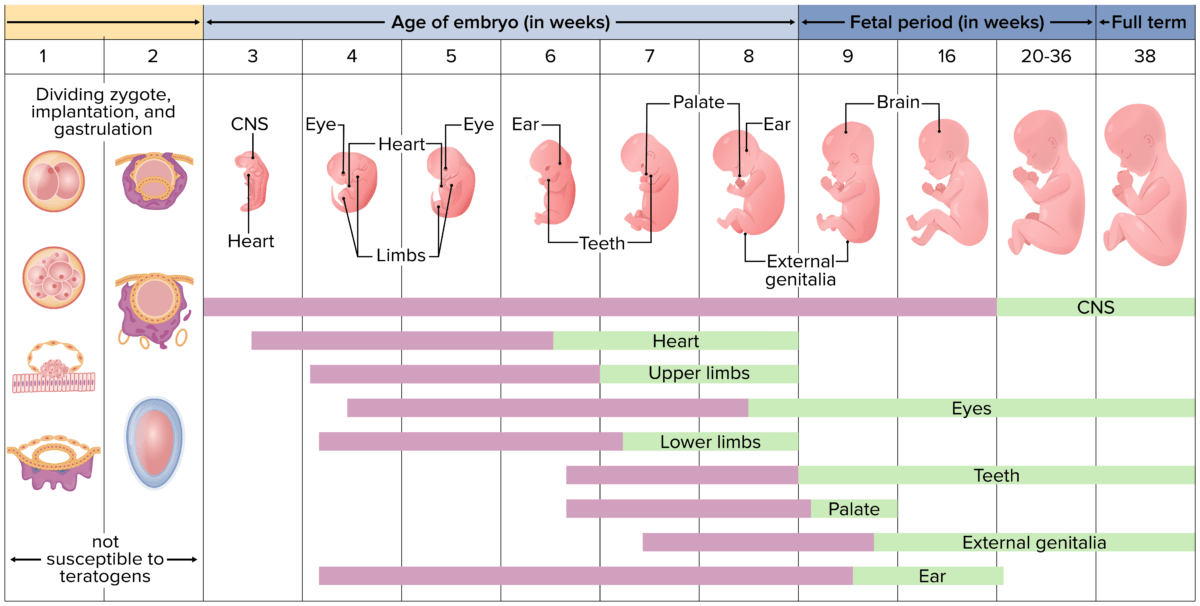I remember being frustrated that the structures that I spent so much time memorizing only existed for days before morphing into something else with a different name. However, it is possible to tackle Embryology. Here are some of the study techniques that worked for my classmates and I.
#1 Focus on Major Events
This is one of the major lessons when it comes to studying in medical school in general. I tend not to be a fan of the metaphor comparing medical school curriculum to drinking from a fire hose, however, the intensity that is conveyed in this metaphor is not hyperbolic. There is an enormous amount of material presented to you during hours of lecture 5 days a week, and it is nearly impossible to even try to learn and remember every single thing you’re taught.
To be successful in studying a complex topic like Embryology, you need to be able to focus on the highlights. Instructors will make it obvious what they think is important for you to know, either by telling you directly or by emphasizing it in their lectures and presentations.
If you are using outside resources, such as Lecturio’s Embryology course, pay attention to what topics come up frequently, especially between multiple resources. Those are the highlights. Those are the things you need to make sure you understand. Beyond that material, you need to prioritize how much extra you want to learn. And the more you want to learn, the more time it’s going to take, and the less time you’ll have to prioritize taking care of yourself or doing literally anything else besides studying.
Anyway, where was I? Ah yes, focus on the major events. There are highlights, and it is important to focus your studying on understanding the major concepts well. In Embryology, some highlights are particularly easy to identify, because each week has milestone events that are frequently tested. For example, the heart begins to beat in week 4, the eyes begin to form in week 5, and the lungs begin to form in week 6. Once you have a solid roadmap of development based on the highlights, the details will come more easily and you will be able to place them into context.

Embryological milestones during the prenatal period
Image by Lecturio, taken from the Online Embryology Course.#2 Use Visual Aids
Visual aids are particularly useful when learning Embryology because it is an abstract topic that can be difficult to construct a mental image for. I recommend that you find a textbook or online resource with images that make sense to you. Stick with this resource as you study, and use the illustrations to guide your visualization of the ongoing processes in fetal development. When you are learning the names of the various structures, make sure to look at the name and the picture of the structure to associate them with one another. It is important that you focus on images from the same source as much as possible, because events in embryology may be depicted quite differently from source to source. You want the images to help solidify the processes in your mind, not muddy the picture because it is difficult to tell what is what when comparing illustrations from different sources.
Since there are many layers and folding events in Embryology, many mnemonics are actually written in a way that depicts what is being described.
For example:
“CAP covers from outside to inside”
C for Clefts- derived from ectoderm
A for Arches- derived from mesoderm and neural crest
P for Pouches- derived from endoderm
These mnemonics help you visualize what is happening while learning important terminology and association between terms.
I personally found videos to be the most helpful resources when studying Embryology. Seeing each structure continually evolving in real time can help you visualize the processes in your head.
You can also make your own visual depictions of Embryological processes by drawing them. This process will both help with repetition (see #3) and reinforce your understanding of the material. In my undergraduate cell biology class, we used modeling clay to build out cellular processes like DNA transcription.
I’m certainly no artist, but it was especially helpful to create 3D renderings of these abstract processes to better understand them. This may be something you’d like to try while studying Embryology as well! Again, be sure to pair your visual aids with the names and key features of each structure.
Related videos
#3 Repetition is Key
Unfortunately, Embryology is a subject in which you simply have to memorize a lot of long words like “syncytiotrophoblast” and “cytotrophoblast”, what they mean, and when they are present. Fortunately, while rote memorization is boring, it comes quite easily to many people with appropriate repetition. Flash cards, either virtual or on paper, are tools that allow for multiple passes (i.e reviews) of material in a short amount of time. In addition, writing notes or summaries of events requires you to think through the material and put it in your own words.
You may also have a list of learning objections or practice questions from your instructor. Make sure you know the answer to those- both why the right answer is right, and why the wrong answers are wrong. The more you can expose yourself to the material and engage with it, whether that be by answering questions, drawing, etc., the more you will remember come test day.
#4 Talk it Out
I have never been someone who particularly likes studying in groups. I’ve always thought, “I’ll have to take the test by myself, so I might as well study by myself to make sure I know everything I need to know.” Typical med student, type A personality, huh?
However, when studying Embryology in particular, I found myself frequently wanting to talk through the material with my classmate and study buddy. One, because she understood the subject much better than I did and two, because talking through the complex events in Embryology helped my mind engage with and therefore remember the material. This is one of the great things about medical school and studying medicine. Individuals have their strong subjects and their weak subjects, and practicing medicine in a team allows us to leverage the strengths of each individual to learn as much as we can and come to the best possible solution to the problem at hand.
On a similar note, if you are struggling academically, it is okay to ask for help. Reach out to your advisors, class counselors or a trusted professor and ask to be connected with tutoring resources.
Best of luck studying Embryology! You’ve got this!





